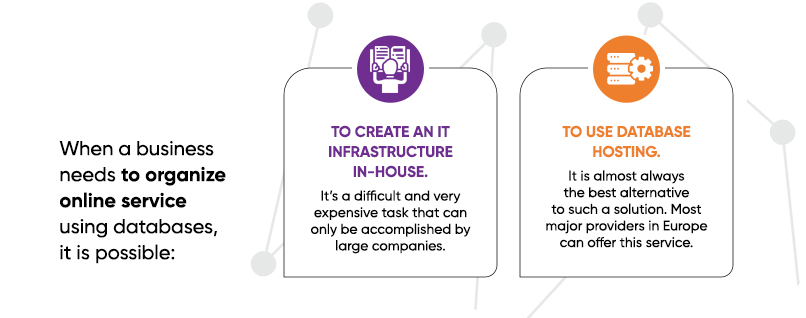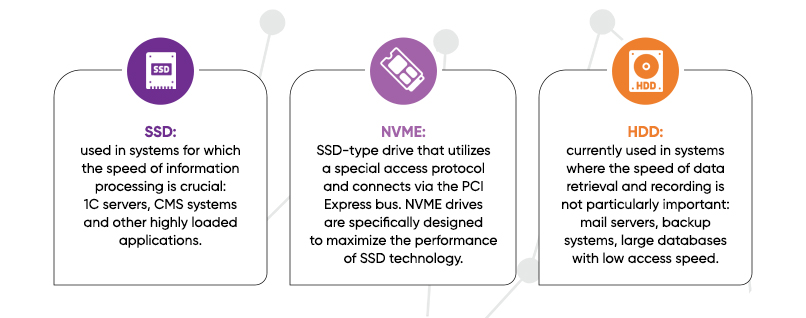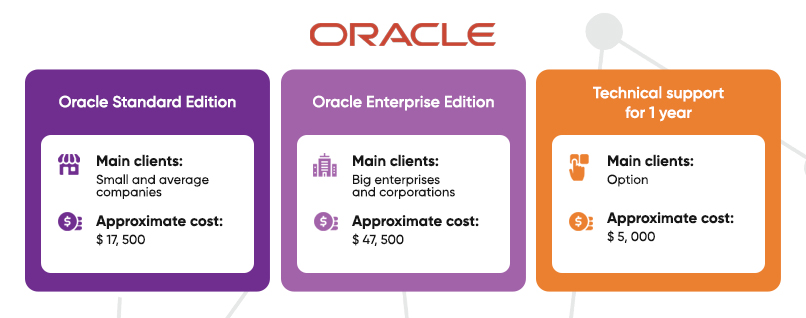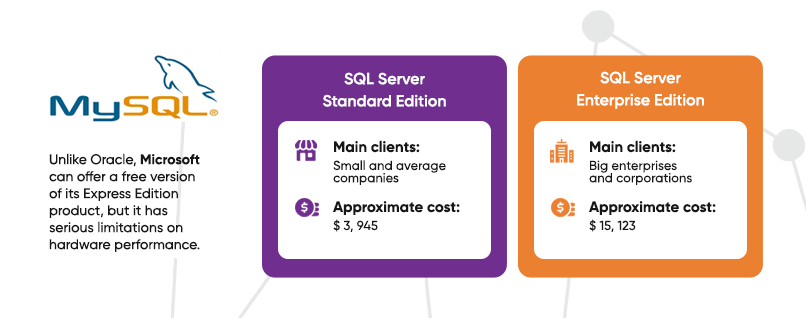Contents
When a business needs to organize online service using databases, it is possible to create an IT infrastructure for this purpose in-house or to ask for help from a provider and give the databases for hosting. Purchasing a server, software configuring and DBMS support are difficult and very expensive tasks that can only be accomplished by large companies that are capable of employing highly qualified IT specialists. Database hosting is almost always the best alternative to such a solution. Most major providers in Europe can offer this service, and the terms of service and rates can be very different. Read about how to select the right database hosting in our article.

Key factors in making database migration decision to new hosting
Often even large enterprises use the services of providers to organize services using DBMS. Hosting will be beneficial if:
- The company has databases, but no specialist to maintain them.
- In-house database administrators are overworked.
- There is no possibility to provide 24/7 support of DBMS operation by the company’s own personnel.
- The workload is small and it is expensive to maintain a specialist.
- The database administrators can handle the work but cannot provide the security level required for the system.
- You have to configure, optimize, or check the DBMS operation efficiency.
Advantages of database hosting
The infrastructure that major European providers are willing to lease for database hosting is physically located in large data centers in Germany, USA, UK and a number of other countries. The advantages of such hosting are:
- High level of reliability of data storage: stable power supply, fire safety and compliance with temperature conditions.
- 24/7 operation of the data center and vast experience of the service personnel.
- Backup and recovery capability.
- Installation of updates and migration to new software versions.
- Database monitoring, optimization, scaling and migration services.
- Reliable protection against DDoS attacks.
- Very fast response to incidents.
- Security guarantees.
- 24/7 technical support.
In addition, almost every provider can offer different hosting options, both for small companies and large corporations.
When selecting a service, it is important to pay attention to the technical parameters of the selected server, take into account the type of DBMS that will be deployed, study the various hosting options and the service provider’s rates. Many providers offer to rent cloud databases DBaaS, which can also be very convenient in some cases.
Server configuration
Provider always offers the client an information about which servers with which configuration are available for rent. In addition, in most cases it is possible to select the right equipment if necessary.
The hardware structure of a server consists of the following components:
- Disk subsystem (type, number and capacity of drives)
- Processor
- RAM
Also the configuration to select from may include: operating system, network connection speed, power supplies, raid levels, etc. The cost of the service may vary depending on the number and performance level of the selected hardware.
Disk subsystem
For a server’s disk subsystem, three types of drives are usually offered:
- SSD: used in systems for which the speed of information processing is crucial: 1C servers, CMS systems and other highly loaded applications. The speed of read/write operations is almost 10 times faster than HDD. Advantages of SSD: weight and dimensions are less than HDD, relatively low power consumption. Disadvantages: limited number of write cycles, relatively high cost.
- NVME: SSD-type drive that utilizes a special access protocol and connects via the PCI Express bus. NVME drives are specifically designed to maximize the performance of SSD technology. Their read/write speeds are 6-7 times faster than conventional SSDs. These disks make sense for demanding CMS, heavy file transfers, and when the performance of conventional SSDs is no longer sufficient.
- HDD: currently used in systems where the speed of data retrieval and recording is not particularly important: mail servers, backup systems, video streaming, large databases with low access speed. The main advantages of HDD: unlimited number of recording cycles, relatively low cost. Another plus – in case of failure of a disk or several disks in an array, it is still possible to extract data from them, even if the controllers or spindle motors have failed. Such procedures are performed in special “clean rooms”. This is not a quick process, but the data can still be retrieved. In SSD/NVME disks, memory chip failure always results in complete data loss with no possibility of even partial recovery. Exceptions are cases when capacitors or controllers on the SSD/NVME disk board fail, if they are replaced there is a chance of data recovery. Disadvantages: low speed of read/write operations, high power consumption, high noise level.

NVME disks are the fastest disks available and can handle almost any number of parallel data accesses. However, NVME-based hardware RAID arrays cannot be built yet, so there is no total transition to the use of NVME disks when organizing storage for databases.

When selecting a disk subsystem, it is fundamentally important to pay attention to the IOPS (Input/Output Operations Per Second) parameter. This is one of the main parameters characterizing the server performance. Experience shows that even with a good processor and a large amount of RAM, performance problems in DBMS operation are most often caused by a wrongly selected configuration of low IOPS drives.
Processor
The higher the likelihood of scaling the database in the future, the higher the processor performance should be. The most important selection criterion is the number of cores. For example, if you can choose between a 4-core processor with a clock speed of 3 GHz and an 8-core processor with a clock speed of 2.5 GHz, you should prefer the second option.
RAM
DBMSs, for which write and read speeds are critical, have high RAM requirements. If the database is installed on a dedicated server, it is necessary to find out what the RAM socket and chipset are. This information will allow you to understand how many channels the RAM has. The more channels, the higher the RAM throughput will be.
Types of databases
There are more than 50 types of databases, and there are even more management systems and specific solutions on the market. Nevertheless, all existing databases are usually divided into two types: relational and non-relational. The former are generalized as SQL and the latter as NoSQL.
The absolute majority of applications are implemented on the basis of relational DBMSs. According to various estimates, SQL accounts for 80% to 90% of the market. The most demanded relational DBMSs are the following:
- MySQL
- PostgreSQL
- Oracle
- MS SQL
Each of them has its own advantages and disadvantages. If you do not fully understand which DBMS is best suited for the project organization, you should study their features.
MySQL
This database is the absolute leader in its class and is perfect for using relatively small web applications with low server load. It is often used by small companies that cannot afford serious expenses on the use of expensive commercial software. MySQL was originally released as an open source solution, but is now owned by Oracle Corporation.
Specifics of licensing
The public version of MySQL community edition can be installed free of charge. It provides a basic set of tools, which is usually enough to implement most basic tasks. At the same time, if a company intends to make improvements or add new features to the software, it must make all its improvements available as open source code to the public. Purchasing a commercial version frees you from the need to comply with public license rules. Depending on the selected version and server performance level, the cost of a commercial license can range from $2,000 to $64,000.
PostgreSQL
PostgreSQL is an object-relational DBMS, which is almost as popular as MySQL. The use of custom objects and tabular data storage allows you to create more complex storage structures. PostgreSQL is available for use with all popular operating systems: Linux, Microsoft Windows, iOS, Android and others.
Specifics of licensing
PostgreSQL is an open source solution and is a completely free, freely distributable product.
Oracle
Oracle is a DBMS that is developed and licensed by Oracle Corporation. It can support various data models: documents, graphs, relational and key values. The latest versions of the software are reoriented to cloud computing.

Specifics of licensing
Oracle DBMS is a fully proprietary product, all editions of which should be purchased. Since the developer sells software licenses rather than software bundles (box editions), the DBMS implementation costs directly depend on the technical parameters of the IT project being implemented. Traditionally, Oracle’s flagship products are two versions of licensed software: Standard Edition and Enterprise Edition. In addition to the product itself, the license price includes the option of consulting with the technical support service for 1 year. After expiration of this period, support services must be paid additionally.
| Product name | Main clients | Approximate cost |
| Oracle Standard Edition | Small and average companies | $ 17, 500 |
| Oracle Enterprise Edition | Big enterprises and corporations | $ 47, 500 |
| Technical support for 1 year | Option | $ 5, 000 |
Microsoft SQL Server
Microsoft SQL Server is a commercially oriented relational DBMS, which is most often used to work with data from web applications. MS SQL is compatible with a large number of data formats and types, effectively supports in-memory computing mechanisms.

Specifics of licensing
Unlike Oracle, Microsoft can offer a free version of its Express Edition product, but it has serious limitations on hardware performance: database size not more than 10 GB, RAM not more than 1 GB, one processor not more than 4 cores. The vendor’s flagship products are commercial DBMS editions: Standard Edition and Enterprise Edition.
| Product name | Main clients | Approximate cost |
| SQL Server
Standard Edition |
Small and average companies | $ 3, 945 |
| SQL Server
Enterprise Edition |
Big enterprises and corporations | $ 15, 123 |

There are two licensing models for Microsoft SQL Server:
- “Server + Clients” (Server+CAL) model. You must purchase a server license and a client license for each device and user that sends a call to the server.
- “Per Core” model. The license does not limit the number of user connections but requires the number of server cores to be taken into account.
DbaaS (Database as a Service).
You can place databases on the provider’s server both in the traditional way and use DbaaS (Database as a Service), i.e. rent an already created database in the cloud.
With the traditional method of organization, the client can choose the configuration of equipment for DBMS placement, but he has to administer the server himself and bear certain expenses:
- You should pay for a license (if it is a commercial version).
- It is necessary to prepare the initial installation of the server.
- It is necessary to ensure stable operation of the database (updates, backups, troubleshooting, etc.).
- It is necessary to ensure the security of the database by yourself (protection from DDoS attacks and actions of intruders).
- It is necessary to employ a database administrator.
In the case of selecting DbaaS service, the client receives a database already deployed in the cloud with fixed performance parameters. In this case, the provider is responsible for resolving all issues of licensing, administration, equipment operation and security.
There are other important advantages in this service model, such as:
- Cloud service can be provided within minutes, it does not require the intervention of highly qualified specialists.
- The client is able to connect new databases, add users and define connection methods using a simple web application.
- Cloud storage security and stable database performance are guaranteed by the service provider via SLAs, often with financial guarantees.
In addition, the service provider may also offer an optional service:
- Configuring data replication and backups.
- Restore the database at any point in time.
- Monitoring tools: slow query logs, control of resource allocation, etc.
- Provision of detailed documentation and helpdesk advice.
Additional services are usually available as paid and free options. The number of services and possible conditions depend directly on the specific provider.
When DbaaS service is most efficient compared to traditional DB hosting in a data center
As practice shows, the DbaaS service is most often demanded in the following cases:
- When additional testing or development capacity is required on pay-as-you-go basis.
- If you require to quickly deploy a database that meets specific safety or regulatory standards.
- When inexpensive storage for database replication is required.
- If the company does not have specialists capable of configuring and administering the DBMS.
How to select a provider in Europe for database hosting
Write us a message to get additional information.
or book a free consultation
When making a choice in favor of cloud-based DBAAS services, you should consider the level of operational costs. These are usually easy to calculate, as providers often use hourly, per-minute or even per-second billing. For long-term projects, the traditional way of organizing databases may prove to be more profitable in the long run than hosting in the cloud. For the same reason, many companies choose DbaaS as a temporary solution.
Especially for you we have prepared additional information that will help you choose database hosting. Download the checklist with offers from 20 major European providers and make the right choice.

Article author
Volodymyr Marchenko
network engineer and a consultant in interactions with leading equipment vendors and manufactures
